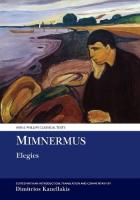
Liverpool (2023) h/b 186 pp £95 (ISBN 9781837642601)
Since 2018 Aris & Phillips Classical Texts have been published by Liverpool UP. The intention of the series was to make some 200-250 classical texts ‘accessible to those without classical languages’ and this complete edition of Mimnermus—a poet surviving in only 17 fragments—is a welcome addition to the series. That said, the title ought to include ‘text’ as well as ‘translation and commentary’ to represent the contents.
The introduction occupies 50 pages with sections on elegy, Mimnermus, archaic Smyrna and reception, while text and translation occupy a slender 8 pages (84 lines of Greek) and the commentary 89 pages. The quantity of comment gives space for discussion of the Greek text and its literary quality. Appendix one (on metrical issues) inevitably requires reference to the relevant word or lines in the Greek text, but Greek is liberally used throughout the editorial material. In the translation K. has ‘tried to stay as close possible to the grammar and syntax of the original text’ while catering ‘for some striking stylistic and rhythmical features’ and recommending readers’ to refer to ‘more poetic’ versions, such as the ‘rhyming gems’ in the Oxford Book of Greek Verse in Translation (1938). (A more vigorous translation of fragment 2 using elegiac couplets can be found in Peter Reading’s Collected Poems vol.3. Its title ‘Mimnermian’ declares its debt and shared sensibility.)
Translation and notes are well deployed to give readers a rich experience of the poetry. For example, at Fr.1.6 the enjambment in Greek of ‘old age’ (not replicated in the translation) comes, as K. observes, at the central position in the poem and highlights the poet’s central concern. A similar enjambment of ‘old age’ appears in the couplet Fr.4. In Fr.1 K. finds a clever echo (‘charmful … harmful’) to represent what K. suggests ‘is intended as a pun’. K. does not only focus on literary features, although this is the primary objective. but includes sparse comments on grammar aimed at advanced readers, and where appropriate on textual matters. But the lack of an apparatus criticus shows that K.’s interests lie elsewhere.
K. is assiduous in presenting this detailed and well-rounded treatment of the poet’s surviving fragments. Besides the joys of youth, the spectre of death and the horrors of old age which loom large, Mimnermus also treats warfare and, famously in Fr.12 the sun’s endless round and conveyance back east in the night. A poet worth a visit, and this a worthy guide, in K.’s words, to a ‘very playful poet … a new Mimnermus whose melancholy is only a generic … pretext’.
Alan Beale
